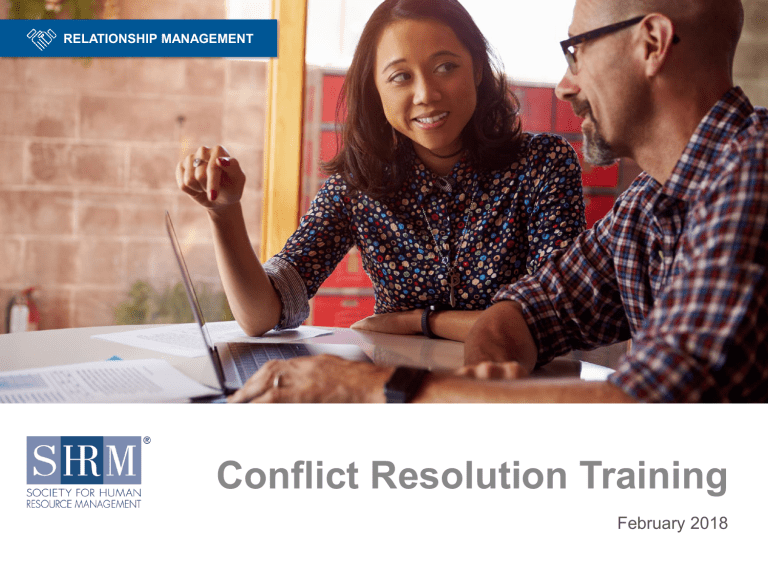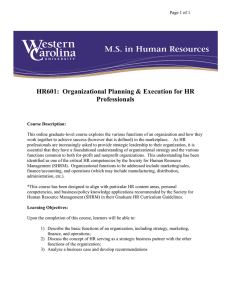
RELATIONSHIP MANAGEMENT
Conflict Resolution Training
February 2018
Introduction
“Whenever you’re in conflict with someone, there is one factor that can
make the difference between damaging your relationship and deepening it.
That factor is attitude.”
—William James
This training focuses on ways that you, as supervisors, can work with your
employees to resolve conflict in the workplace. It provides practical steps
and techniques that everyone can learn.
The purpose of this presentation is to provide you with the knowledge to
recognize causes of workplace conflict, how to facilitate resolution of conflict
and how to manage the work relationships once the conflict has been
resolved.
RELATIONSHIP MANAGEMENT
© 2016 SHRM. All rights reserved.
2
Agenda
1. Causes of workplace conflict
2. Importance of resolving conflict
3. Methods of resolving conflict
4. Do’s and don’ts of workplace conflict
5. Steps in the conflict resolution process
RELATIONSHIP MANAGEMENT
© 2016 SHRM. All rights reserved.
3
Causes of Workplace Conflict
Conflict arises because employees:
•
•
•
•
•
Have different points of view.
Communicate with one another differently.
Spend large amounts of time together.
Depend on one another to “get the job done.”
Have established expectations of one another that are not
communicated and then not met.
RELATIONSHIP MANAGEMENT
© 2016 SHRM. All rights reserved.
4
Causes of Workplace Conflict
(cont.)
Conflict does not always have to be negative. When employees are able to
challenge one another’s ideas in a supportive environment, new ideas are
generated and fostered.
It is important to remember that conflict will always exist between
employees. Effective supervisors have the skills to manage the conflict
process and turn disagreements into ideas.
RELATIONSHIP MANAGEMENT
© 2016 SHRM. All rights reserved.
5
Causes of Workplace Conflict
(cont.)
Examples of Healthy vs. Damaging Conflict
Healthy conflict:
• Disagreements
communicated in a
supportive environment
that foster the generation
of new ideas or ways to
problem-solve.
• Tension that increases
awareness or sheds light
on a growing workplace
problem.
RELATIONSHIP MANAGEMENT
Damaging conflict:
• Name calling.
• Personal attacks.
• Employees becoming
silent, withdrawn and/or
afraid to speak up.
• Cliques, gossip and
rumors.
• Lack of mutual respect.
© 2016 SHRM. All rights reserved.
6
Questions? Comments?
RELATIONSHIP MANAGEMENT
© 2016 SHRM. All rights reserved.
7
Importance of Resolving Conflict
Why should we get involved? It’s their problem, right?
No—you, as supervisors, must learn to manage conflicts among your team
members so that the business continues to run effectively and objectives
are met.
RELATIONSHIP MANAGEMENT
© 2016 SHRM. All rights reserved.
8
Importance of Resolving Conflict
(cont.)
Consequences of letting conflict fester:
• Employees not involved in the conflict either “pile on” or withdraw from
the conflict.
• Employees take sides or “check out” from work entirely.
• Morale and productivity are lowered because employees are focused on
the conflict.
• Employees who work in teams are now divided because of the conflict.
RELATIONSHIP MANAGEMENT
© 2016 SHRM. All rights reserved.
9
Importance of Resolving Conflict
(cont.)
In extreme instances, unresolved conflict can lead to violent or aggressive
situations.
• Employees may become injured.
• The company may have legal risks associated with violent situations
in the workplace.
• Work can slow dramatically or halt altogether.
RELATIONSHIP MANAGEMENT
© 2016 SHRM. All rights reserved.
10
Questions? Comments?
RELATIONSHIP MANAGEMENT
© 2016 SHRM. All rights reserved.
11
Methods of Resolving Conflict
There are five basic ways of handling conflict in the workplace:
• Competing.
• Collaborating.
• Compromising.
• Avoiding.
• Accommodating.
There is no one way to resolve a conflict, and often managers need to use
multiple methods to reach a resolution.
(Source: Thomas-Kilmann Conflict Mode Instrument)
RELATIONSHIP MANAGEMENT
© 2016 SHRM. All rights reserved.
12
Methods of Resolving Conflict
(cont.)
Competing
The competing method involves handling the conflict through unilateral
decision-making. This approach is most appropriately used by managers
and leaders in the workplace.
The competing method is used primarily for:
• Situations that involve quick action.
• Instances in which there is no compromise or debate.
• Situations requiring the need to make hard or unpopular decisions.
RELATIONSHIP MANAGEMENT
© 2016 SHRM. All rights reserved.
13
Methods of Resolving Conflict
(cont.)
Collaborating
The collaborating method involves handling the conflict through team input.
This technique is particularly useful if all parties in the conflict want to find a
resolution but are unable to agree on what the resolution should be.
The collaborating method is used primarily for:
• Gaining support from the team.
• Using the different perspectives as an opportunity to learn.
• Improving relationships through collaboration.
RELATIONSHIP MANAGEMENT
© 2016 SHRM. All rights reserved.
14
Methods of Resolving Conflict
(cont.)
Compromising
The compromising method involves handling the conflict by reaching a
resolution that involves a “win” on both sides of the table.
The compromising method is used primarily for:
• Resolving issues of moderate to high importance.
• Finding a solution that involves equal power and strong commitment on
both sides.
• Situations needing a temporary fix.
• Backing up a decision that was made using the competing or
collaboration methods.
RELATIONSHIP MANAGEMENT
© 2016 SHRM. All rights reserved.
15
Methods of Resolving Conflict
(cont.)
Avoiding
The avoiding method is a way of handling conflict by making an active
decision not to handle the conflict. This approach is best used for situations
that are not related to work and that should be solved through another
means.
The avoiding method is used primarily for:
• Unimportant or nonwork-related issues.
• Buying time until a resolution can be reached.
• Recognizing issues as symptoms.
RELATIONSHIP MANAGEMENT
© 2016 SHRM. All rights reserved.
16
Methods of Resolving Conflict
(cont.)
Accommodating
The accommodating method is a way of handling conflict by allowing the
other side to “win.”
The accommodating method is used primarily for:
• Maintaining perspective in a conflict situation.
• Making active decisions on what can be “let go” vs. what needs another
method.
• Keeping the peace and creating goodwill.
RELATIONSHIP MANAGEMENT
© 2016 SHRM. All rights reserved.
17
Questions? Comments?
RELATIONSHIP MANAGEMENT
© 2016 SHRM. All rights reserved.
18
Do’s and Don’ts of Resolving
Conflict
Do:
•
•
•
•
•
•
Understand that conflicts are inevitable.
Resolve to address conflict quickly.
Focus on the problem.
Be open to solutions.
Acknowledge how employees are feeling.
Listen actively.
RELATIONSHIP MANAGEMENT
© 2016 SHRM. All rights reserved.
19
Do’s and Don’ts of Resolving
Conflict (cont.)
Don’t:
•
•
•
•
•
•
•
Focus on personality traits that cannot be changed.
Interrupt.
Attack.
Disregard the feelings of employees.
Avoid the conflict.
Allow emotions to take over the conversation.
Impose personal values or beliefs.
RELATIONSHIP MANAGEMENT
© 2016 SHRM. All rights reserved.
20
Questions? Comments?
RELATIONSHIP MANAGEMENT
© 2016 SHRM. All rights reserved.
21
Steps in the Conflict Resolution
Process
There are six steps to the conflict resolution process:
1. Clarify what the disagreement is.
2. Establish a common goal for both parties.
3. Discuss ways to meet the common goal.
4. Determine the barriers to the common goal.
5. Agree on the best way to resolve the conflict.
6. Acknowledge the agreed solution and determine the responsibilities
each party has in the resolution.
This process should be completed by all parties in the conflict together.
(Source: Conflict Resolution Skills for HR Professionals by Marla Bradley)
RELATIONSHIP MANAGEMENT
© 2016 SHRM. All rights reserved.
22
Steps in the Conflict Resolution
Process (cont.)
Step 1: Clarify what the disagreement is.
Clarifying involves getting to the heart of the conflict. The goal of this step is
to get both sides to agree on what the disagreement is.
Tips:
• Discuss what needs are not being met on both sides of the conflict.
Ensure mutual understanding.
• Obtain as much information as possible on each side’s point of view.
• Continue to ask questions until you are certain that you, and each side of
the conflict, understand the issue.
RELATIONSHIP MANAGEMENT
© 2016 SHRM. All rights reserved.
23
Steps in the Conflict Resolution
Process (cont.)
Step 2: Establish a common goal for both parties.
In this step of the process, both sides agree on the desired outcome of the
conflict.
Tips:
• Discuss what each party would like to see happen.
• Find a commonality in both sides as a starting point for a shared
outcome. That commonality can be as simple as “both sides want to end
the conflict.”
RELATIONSHIP MANAGEMENT
© 2016 SHRM. All rights reserved.
24
Steps in the Conflict Resolution
Process (cont.)
Step 3: Discuss ways to meet the common goal.
Both sides work together to discuss ways that they can meet the goal they
agreed on in step 2.
Tips:
• Brainstorm different approaches to meet the goal.
• Discuss until all the options are exhausted.
RELATIONSHIP MANAGEMENT
© 2016 SHRM. All rights reserved.
25
Steps in the Conflict Resolution
Process (cont.)
Step 4: Determine the barriers to the common goal.
In this step of the process, the two parties acknowledge what has brought
them into the conflict.
Tips:
• Ask, “If we could have the outcome that we both wanted, how would that
look?”
• Define what can and cannot be changed about the situation.
• For the items that cannot be changed, discuss ways of getting around
those road blocks.
RELATIONSHIP MANAGEMENT
© 2016 SHRM. All rights reserved.
26
Steps in the Conflict Resolution
Process (cont.)
Step 5: Agree on the best way to resolve the conflict.
Both parties come to a conclusion on the best resolution.
Tips:
• Determine a solution that both sides can live with.
• Discuss the responsibility each party has in maintaining the solution.
• Settle on a means of ensuring that this conflict does not arise again.
RELATIONSHIP MANAGEMENT
© 2016 SHRM. All rights reserved.
27
Steps in the Conflict Resolution
Process (cont.)
Step 6: Acknowledge the agreed solution and determine the responsibilities
each party has in the resolution.
Both sides own their responsibility in the resolution of the conflict and
express aloud what they have agreed to.
Tips:
• Get both parties to acknowledge a win-win situation.
• Ask both parties to use phrases such as “I agree to . . .” and “I
acknowledge that I have responsibility for . . .”
RELATIONSHIP MANAGEMENT
© 2016 SHRM. All rights reserved.
28
Questions? Comments?
RELATIONSHIP MANAGEMENT
© 2016 SHRM. All rights reserved.
29
Summary
Conflict is inevitable in the workplace. There is healthy and damaging
conflict.
Some causes of workplace conflict are:
• Employees with different points of view.
• Employees who communicate differently.
• Employees spending large amounts of time together.
It is important to address conflict because unresolved conflict leads to low
morale, productivity and, in extreme cases, workplace violence.
RELATIONSHIP MANAGEMENT
© 2016 SHRM. All rights reserved.
30
Summary (cont.)
The five methods of resolving conflict are:
•
•
•
•
•
Competing.
Collaborating.
Compromising.
Avoiding.
Accommodating.
RELATIONSHIP MANAGEMENT
© 2016 SHRM. All rights reserved.
31
Summary (cont.)
The six steps in the conflict resolution process are:
1.
2.
3.
4.
5.
6.
Clarify what the disagreement is.
Establish a common goal for both parties.
Discuss ways to meet the common goal.
Determine the barriers to the common goal.
Agree on the best way to resolve the conflict.
Acknowledge the agreed solution and determine the responsibilities
each party has in the resolution.
RELATIONSHIP MANAGEMENT
© 2016 SHRM. All rights reserved.
32
Questions? Comments?
RELATIONSHIP MANAGEMENT
© 2016 SHRM. All rights reserved.
33
Training Evaluation
Please be sure to complete the evaluation sheet you received with your
handouts.
I thank you for your interest and attention!
RELATIONSHIP MANAGEMENT
© 2016 SHRM. All rights reserved.
34



